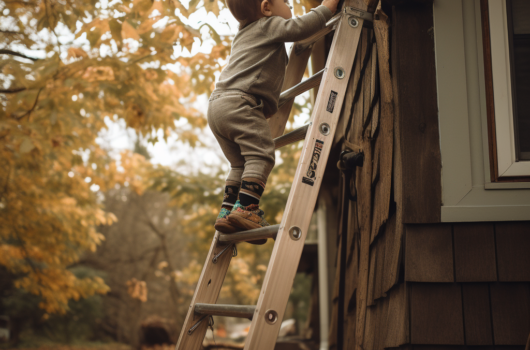Toddlers are known for their boundless energy and curiosity, which often leads them to explore their surroundings in unconventional ways. One common behavior that many parents encounter is climbing. Whether it’s scaling furniture or attempting to conquer playground structures, toddlers seem to have an innate desire to reach new heights. While this behavior can be both exciting and nerve-wracking for parents, understanding the nature of a toddler’s exploration is crucial in managing their climbing tendencies effectively. In this article, we will delve into various aspects of managing a climbing toddler, including creating a secure environment, setting boundaries, engaging alternatives, effective communication strategies, and when seeking professional help becomes necessary.
- The Curious Climber: Understanding the Nature of a Toddler’s Exploration
- Safety First: Creating a Secure Environment for Your Adventurous Toddler
- Setting Boundaries: Establishing Rules and Limits to Manage Climbing Behavior
- Engaging Alternatives: Fun Activities to Redirect Your Climbing Toddler’s Energy
- Communication is Key: Effective Strategies for Teaching Boundaries and Safety Measures
- Seeking Professional Help: When to Consult an Expert for Managing Extreme Climbing Behaviors
The Curious Climber: Understanding the Nature of a Toddler’s Exploration
Toddlers are naturally curious beings who learn about the world through hands-on experiences. Their desire to climb stems from their need for exploration and mastery over their environment. According to child development experts at Stanford University School of Medicine (2019), climbing helps toddlers develop gross motor skills such as balance and coordination while also fostering cognitive growth by challenging problem-solving abilities.
However, it is essential to recognize that not all children exhibit the same level of interest in climbing activities. Some may be more inclined towards physical challenges than others due to individual temperament or personality traits. As Dr. Jane Nelsen explains in her book “Positive Discipline,” some children have what she calls an “adventurous spirit” (2006). These children tend to seek out opportunities for excitement and stimulation through activities like climbing.
Safety First: Creating a Secure Environment for Your Adventurous Toddler
Ensuring your home provides a safe environment is paramount when dealing with a climbing toddler. Statistics show that falls are one of the leading causes of injury among young children (Centers for Disease Control and Prevention [CDC], 2021). To prevent accidents, it is crucial to secure furniture and other potential climbing hazards. Anchoring bookshelves, dressers, and televisions to the wall can significantly reduce the risk of tipping over.
Additionally, installing safety gates at staircases or blocking off areas with potential dangers such as balconies or open windows is essential. Softening hard surfaces by using padded mats or rugs can also minimize injuries in case of falls. Regularly inspecting your home for any new climbing opportunities that may arise as your toddler grows is vital to maintaining a safe environment.
Setting Boundaries: Establishing Rules and Limits to Manage Climbing Behavior
While it’s important to encourage exploration and physical activity in toddlers, setting boundaries becomes necessary when managing their climbing behavior. Clearly communicating rules regarding what objects are off-limits for climbing helps establish expectations from an early age. For example, explaining that chairs are meant for sitting rather than scaling can help redirect their energy towards appropriate activities.
Consistency is key when enforcing these boundaries. According to Dr. Alan E Kazdin, professor of psychology at Yale University (2016), children respond best when they understand that certain behaviors consistently result in specific consequences – both positive and negative. By consistently reinforcing limits on climbing behavior while providing alternative outlets for their energy, parents can effectively manage this challenging phase.
Engaging Alternatives: Fun Activities to Redirect Your Climbing Toddler’s Energy
Redirecting a toddler’s energy towards more suitable activities not only keeps them engaged but also reduces the likelihood of dangerous climbs. Providing ample opportunities for active play outdoors allows toddlers to explore their physical capabilities safely while burning off excess energy.
Activities such as supervised visits to playgrounds equipped with age-appropriate structures offer a controlled environment where children can climb under adult supervision. Indoor play spaces designed specifically for young children often include soft play equipment like foam blocks or mini obstacle courses that provide similar benefits without the risks associated with climbing on furniture.
Communication is Key: Effective Strategies for Teaching Boundaries and Safety Measures
Clear communication plays a vital role in managing a climbing toddler. Explaining the reasons behind certain rules helps children understand the importance of safety while also fostering their ability to make informed decisions. Using simple language and visual aids, such as pictures or diagrams, can enhance comprehension for young children.
Positive reinforcement is another effective strategy when teaching boundaries and safety measures. Praising your child’s efforts to follow the rules encourages them to continue making safe choices. For example, acknowledging their decision to use a step stool instead of climbing onto countertops reinforces positive behavior.
Seeking Professional Help: When to Consult an Expert for Managing Extreme Climbing Behaviors
While climbing is a normal part of toddler development, some children may exhibit extreme or dangerous behaviors that require professional intervention. If your child consistently engages in risky climbs despite consistent redirection and boundary-setting efforts, it may be time to consult with experts such as pediatricians or child psychologists.
These professionals can assess whether there are underlying issues contributing to excessive climbing behaviors, such as sensory processing disorders or attention deficit hyperactivity disorder (ADHD). Early intervention can help address any potential developmental delays or behavioral challenges that may be influencing your child’s propensity for climbing beyond what is considered typical.
Managing a climbing toddler requires understanding their natural inclination towards exploration while ensuring their safety remains paramount. By creating secure environments, setting clear boundaries, providing engaging alternatives, employing effective communication strategies, and seeking professional help when necessary, parents can navigate this phase successfully. Remember that each child develops at their own pace; patience and consistency are key elements in guiding them through this adventurous stage of life.
